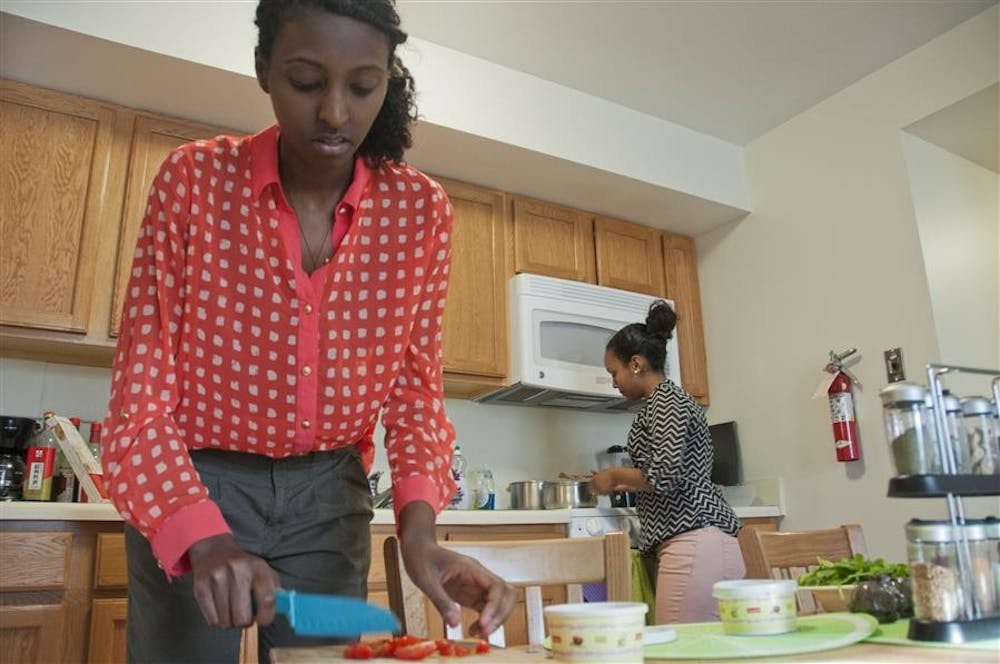Selam Adhanom called her dad to say she wanted to come home. A summer 2010 participant in the Groups Program, the soon-to-be freshman at IU wasn’t used to the American food they’d been serving in the dining halls.
It had been making her vomit.
Raised in the small Northeastern African country of Eritrea for seven years, Adhanom had been raised on Shiro and Dorho tsebhi.
The Groups Scholars Program, an initiative that prepares first generation college students for college at IU, had brought Adhanom to IU for the summer, but she wasn’t sure she could handle the food for another four years.
Adhanom said that halfway through the summer session, she increasingly got physically sick from the campus food.
“I lost like 15 pounds,” she said. “Everything I ate, my body would just throw up the food. I wasn’t used to eating American food all the time. That’s when I realized how Eritrean I was.”
Adhanom’s family moved to Indiana when she was just seven years old, seeking education and opportunity.
Because the path to citizenship for international immigrants requires a five-year residency period, the process for Adhanom was prolonged.
Additional safety measures due to the 9/11 terrorist attacks didn’t make the process any easier, she said.
Adhanom did not become an official U.S. citizen until last year.
Even though she lived in the United States throughout middle and high school, she said it still took her a long time to feel like an American once she got to college.
Her home in Indianapolis was as close as she could get to Eritrea, a small country in Northern East Africa.
“In our house, English is forbidden,” Adhanom said. “We don’t speak in English. We don’t eat American food, unless we go out. It was a big culture shock coming here. So to a certain point, I did feel like an international student.”
Eating in the dining halls was a burden every day during her freshman and sophomore years. She said she just couldn’t get accustomed to the new food.
“I took every opportunity to go home,” Adhanom said. “If it wasn’t for that I would have quit halfway through the program.”
The only American foods she can digest are pasta, rice and certain snacks.
“I almost went through depression, just being away from home,” Adhanom said. “I wasn’t eating that much. I wasn’t sleeping. I didn’t like being here at all. If it wasn’t for my roommates, who are also Eritrean/Ethiopian, I probably would’ve left.”
Adhanom relies on her mother sending or bringing her food. Now that she works two jobs and serves as treasurer for the African Student Association, she rarely has time to eat.
She and her “habesha” roommates — a term for Ethiopian and Eritrean people — have their own kitchen. Their parents send ingredients from home — sauces and spices like silsi and berbere, and fresh, unprocessed chicken, lamb and goat to make meals in their apartment.
Residential Programs and Services Dining Services provides food for students all over campus in 20 different food facilities. They accommodate for vegan, vegetarian and other dietary needs, said Sandra Fowler, RPS dining services director. If a student has particular diet restrictions, they can express their concerns to the RPS dietitian, Fowler said.
When it comes to culturally and international inspired foods, Fowler said that RPS Dining Services also offers a wide range of options around the campus.
“We have different Latin foods, we have Asian foods, we have new items that we rotated throughout or have had concepts at our food courts,” Fowler said. “Even in our school of business café, we have a different ethnic entry every day.”
Ancil Drake, the RPS director for production and procurement, said that the RPS staff, including the chefs, experiment with new recipes to create food concepts, then present it for a trial period. The success of the ethnic food concepts is primarily based on how popular the food items are.
Drake said that at the Kelley School of Business Campus Café, ethnic foods are rotated throughout the week.
“We work with a group of students in a meal plan committee,” Fowler said. “These are students that represent the various regions area. We meet every other week and discuss feedback that they have, suggestions they have, any time we’re going to bring in a new concept.”
There are also food committees for a particular dining site, and they operate under student government. Fowler said that there’s a lot of international students who work in the RPS dining services areas. However, both Fowler and Drake agreed that they don’t often receive much input from the non-employee international student population.
“They might not be aware,” Drake said. “We try to encourage students to join these local food committees because those committees meet with the managers on a regular basis.”
Drake said that the managers are then empowered to act on some of the concerns. If the manager can’t act on it, they can bring the issue to the administrative team to make decisions.
Fowler believes a new dining area in Forest Quad will offer better, more internationally diverse options for students.
The flyer has hardly been advertised to the student population, at least not yet. It reads, “The Restaurants at Woodland: Created, planned, tweaked, finessed, contemplated, and designed. Just for you.”
This new conception will have a brick oven to cook pizza and also fresher foods from a variety of different places of influence. Not only will there be food places that will serve grilled meats and Italian food, there will also be a place called “Fusion” which will offer food ranging from Korean food to Mediterranean to Ethiopian.
Fowler, who has worked in RPS Dining Services for about 40 years, said that in the 1970s, RPS Dining Services would showcase a different ethnic meal every month.
“It might be Brazilian, Italian, German,” Fowler said. “Each month we would try to get as many authentic recipes as we could make them, this is when we did traditional dining — when every center had a dining room and we served the same meal in all the dining halls. To get variety we would have some international meals, and then the popular recipes would be incorporated in the cycle of menus.”
Sue Huang attended IU in the mid 1980s as a Taiwanese international student pursuing her master’s degree. Huang said in an email that she stayed in Eigenmann Residence Center for some time before she moved to Collins Living-Learning Center after one semester. Huang remembers making the American food in the main library and Eigenmann cafeteria work for her taste as an international Taiwanese student. “At that time, the food served in the cafeteria was quite American. I don’t think the food was international at all. But that is all right in teaching us about American food. We managed to make food Taiwanese anyway. That is why we all try our best to move away from dorms so that we can cook for ourselves.”
More than 25 years later, RPS is still having a hard time getting student input from the surveys they send out every year.
Adhanom said she’s never seen an RPS survey to voice her concerns about the food services.
“I’m sure there’s a lot people that feel the way I do, who struggle with the same thing I did,” Adhanom said. “I’m sure it’s hard for not just international students, but like Islamic, Jewish and other students.”
Adhanom said she feels that RPS doesn’t do enough to accommodate international students here.
“It’s kind of like they want them here for like tuition payment,” Adhanom said. “But they don’t do a lot to make them feel comfortable. They kind of have to create their own thing to have a community here.”
Students request ethnic food in dining halls

Get stories like this in your inbox
Subscribe





